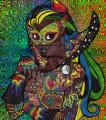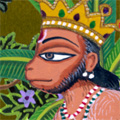
DMT-Nexus member
    
Posts: 1367 Joined: 19-Feb-2008 Last visit: 12-Jun-2016 Location: Pacific Northwest
|
Thanks to the work of Google (on books.google.com) and Microsoft (who provides the resources for many of the books scanned at archive.org/details/texts) there are some great old references available for free reading and download. I thought it would be nice to have a thread where we can share useful references on (or related to) psychoactive plants as we find them. I'll add more as I have time; I don't have the links bookmarked for all the copyright-free texts I've downloaded over the years. For a list of great books on entheogens and psychoactive plants (regardless of whether they're in the public domain), see the related thread: Recommended entheogen reference books. General references covering a variety of substances- Ritual enemas and snuffs in the Americas by Peter A.G.M. de Smet. 1985. The section on enemas covers includes Anadenanthera seeds, ayahuasca, brugmansia, datura, guayusa, peyotl, and tobacco. The section on snuffs covers calamus, Anadenanthera seeds, ayahuasca, cannabis, datura, coca, guayusa, Justicia pectoralis, tobacco, and Virola. The main pdf link is from the Foundation for the Advancement of Mesoamerican Studies; the publisher also has it freely available, though it's split into six seperate files: pp. 1-18, pp. 19-72, pp. 73-120, pp. 121-132, pp. 133-178, pp. 179-280.
- The Chemistry of Common Life by James Johnston. 1854. The section on "The Narcotics We Indulge In" covers hops, opium poppies, cannabis, betel, kava, coca, fly agarics, and datura; "The Beverages We Infuse" covers tea, coffee, and cacao.
- The Seven Sisters of Sleep by Mordecai Cubitt Cooke. 1860. Covers tobacco, opium, hashish, betel, coca, datura and henbane, and fly agarics.
- Die narkotischen Genußmittel und der Mensch by Ernst von Bibra. 1855. Covers coffee, tea, mate, guarana, chocolate, khat, the fly agaric, datura, coca, opium, hashish, tobacco, and betel. This will only be useful if you can speak German. The book was translated to English and published in 1994 as Plant Intoxicants (with technical notes by Jonathan Ott) and is generally avaialble used for under $10.
- Ethnopharmacologic Search for Psychoactive Drugs, edited by Daniel Efron. 1967. This one is courtesy of Erowid. The symposium particularly covered kava, nutmeg, South American snuffs, ayahuasca, and the fly agaric. It includes contributions from Richard Evans Schultes, Sasha Shulgin, Gordon Wasson, and a number of other good names in ethno/psychopharmacology.
Sources covering particular substancesAyahuasca- Ayahuasca: alkaloids, plants & analogs by Keeper of the Trout. 1st edition 1998; this is the 2004 2nd edition. Not old, but the author has waived copyright on the text; hosted courtesy of Erowid.
CannabisCocaCoffeeMushrooms- Mushrooms, Russia, and History (Volume 1 and Volume 2) by R. Gordon Wasson and Valentina Wasson. 1957. Very rare book (only 500 copies ever printed), available courtesy of the New Alexandria Archive.
OpiumSyrian Rue- Haoma and Harmaline by David Stophlet Flattery and Martin Schwartz. 1989. Not available for download, but the full book is available for online reading. It has plenty of technical (and some factual) flaws, but is certainly a worthwhile reference.
Other noteworthy texts- Harvard University's Botanical Museum Leaflets. The Missouri Botanical Museum Library has the entire series of these leaflets (from 1932-1986) available for reading and download. Wasson has articles in volumes 19, 20, 23, and 26. Hofmann has an excellent article in volume 20 detailing the chemistry of ololiuqui (Turbina corymbosa) to accompany Wasson's ethnographic report on the seeds in the same volume. Schultes has articles in a whole load of volumes, but the really crunchy articles are in volumes 4 (peyotl), 5 (peyotl), 7 (truly landmark, first english language article firmly establishing the Mexican entheogen teonanacatl as a Basidiomycete), 16, 18, 22, 23, and 28.
- Shulgin's notebooks. The team at erowid has been working hard to make Shulgin's notebooks available to the public. They include extensive notes on Shulgin's sampling of novel compounds as he was developing them, as well as accounts from others in his "research group" after Shulgin had established an effective dosage range. These are an absolutely fascinating slice of history. Currently two of the three notebooks are available. The third is in the process of being anonymized to protect the identities of Shulgin's friends and associates prior to scanning.
Travelogues and other early literature with historically relevant accounts- Notes of a Botanist on the Amazon and Andes (Volume 1 and Volume 2) by Richard Spruce. 1908. Spruce was a pioneering ethnobotanist and a sort of personal hero of Schultes. This book records his explorations of South America from 1849-1864. Includes information on Anadenanthera snuffs, coca, and more.
- Natural and Moral History of the Indies by José de Acosta. Originally published 1590; this 1880 edition contains books 1-4 and is from the 1604 English translation by Edward Grimston; books 5-7 are available in html format. Acosta commented on the use of coca, cacao, ololiuhqui, and tobacco.
- Cuatro libros de la Naturaleza y virtudes de las plantas y animales de uso medicinal en la Nueva España by Francisco Hernández. Original in Latin composed late 16th century and published in 1628; this Spanish partial translation by Francisco Ximénez was originally published 1615. The book includes descriptions of ololiuhqui, tobacco (picietl), mushrooms (teonanácatl, teyhuinti), and chocolate (cacahuatl).
- Historia de las Indias de Nueva-España y islas de Tierra Firme (Volume 1 and Volume 2) by Diego Durán. Originally published 1587; this edition published 1880. No English translations are available for download that I've found (though it has been translated). Durán is an important early post-Conquest source who had a great deal of respect for the Aztec culture.
- The royal commentaries of Peru, Vol. 1 by Garcilaso de la Vega. Orginal published in Spanish in 1608; English translation 1688 by Paul Rycaut. Garcilaso's served under Pizarro, and his mother was a cousin of the Incan emperor Atahualpa, giving him a unique perspective on the early post-conquest period in Peru. He discusses coca (of which he owned a plantation) and tobacco. I haven't yet found a digital edition of the second volume.
- Exploration of the Valley of the Amazon by William Lewis Herndon. 1854. Report on an expedition undertaken at the direction of the US Navy. Comments on the indigenous use of coca, and comments some on tobacco (mostly from an economic standpoint).
- Historia Antigua de México by Francisco Javier Clavigero. Originally published 1780; this edition published 1868. No English edition found online. Contains a rare 18th-century reference to ololiuhqui seeds (which otherwise seem to have dropped entirely out of Spanish awareness in that century); the account appears to be an amalgamation of Acosta and Durán's 16th century descriptions of Aztec traditions.
- Das Nord- und Östliche Theil von Europa und Asia by Philipp Johann von Strahlenberg. 1730. Strahlenberg was a Swede taken as a prisoner of War after a defeat by Russians in 1709. He was taken to Siberia, where he remained for twelve years, during which time he undertook several journeys exploring and mapping the region. This publication contains a description of life among the Koryaks of the Kamchatka peninsula. Not only was this the first unambiguous European reference to the recreational use of fly agaric mushrooms, it also contained descriptions of the urine-drinking practices associated with the mushroom in that region.
- History of Kamtschatka, and the Kurilski Islands, With the Countries Adjacent by Steppan Krasheninnikov. Original published 1755 in Russian; this English translation by James Grieve published 1764. Another early account containing descriptions of fly agaric use.
- Beschreibung von dem lande Kamtschatka by Georg Wilhelm Steller. 1774. No English edition available online. Another early source with an account of fly agaric usage.
- Das Muscarin: Das giftige Alkaloid des Fliegenpilzes by Oswald Schmiedeberg and Richard Koppe. 1869. Not available in English. Account of the discovery of muscarine (not muscimol), isolated from fly agarics.
- Personal Narrative of Travels to the Equinoctial Regions of America, During the Years 1799-1804 by Alexander von Humboldt and Aimè Bonpland Volume I, Volume II, and Volume III by Alexander von Humboldt. Original in French (1807); this English translation by Thomasina Ross (1852). Contains the first report on the use of yopo snuff. Humboldt and Bonpland also encountered guarana (Paullinia cupana) a species of Banisteriopsis and of Brugmansia, and Theobroma bicolor (a species related to the cacao tree).
- An historical relation of the island Ceylon, in the East-Indies by Robert Knox. 1681. An early English-language account describing betel-chewing practices.
|

Got Naloxone?
 
Posts: 3240 Joined: 03-Aug-2009 Last visit: 11-Mar-2025 Location: United Police States of America
|
Ummmm, WOW Entropymancer. Thank you so much for this stellar list of resources. Talk about the real mind candy. And mind meat/tofu.  "But even if nothing lasts and everything is lost, there is still the intrinsic value of the moment. The present moment, ultimately, is more than enough, a gift of grace and unfathomable value, which our friend and lover death paints in stark relief."-Rick Doblin, Ph.D. MAPS President, MAPS Bulletin Vol. XX, No. 1, pg. 2Hyperspace LOVES YOU
|

DMT-Nexus member
Posts: 102 Joined: 12-Jan-2011 Last visit: 01-Sep-2013 Location: Reality
|
Excellent list. Good work and contribution. Psikotrope AKA Hanuman Dass http://hanumandass.wordpress.com A blog on nonduality, entheogens, and other such topics. "It can be what you want it to be but in the end it's all just sensory enhancement." -The thought stream that once saved my life.
|

DMT-Nexus member
    
Posts: 1367 Joined: 19-Feb-2008 Last visit: 12-Jun-2016 Location: Pacific Northwest
|
Pandora wrote:Ummmm, WOW Entropymancer. Thank you so much for this stellar list of resources. Talk about the real mind candy. And mind meat/tofu.  I just collect this stuff, that's the easy part. I want to thank the libraries who kept these books in good condition for so many years, and the folks who took the time to scan them all!
|

DMT-Nexus member
    
Posts: 1367 Joined: 19-Feb-2008 Last visit: 12-Jun-2016 Location: Pacific Northwest
|
A couple more books available as free pdfs courtesy of the folks at erowid: - Hallucinogens and Culture by Peter Furst (1976). Definitely worth the read.
- Psychedelics Encyclopedia by Peter Stafford (3rd edition, 1992). Far from my favorite book on the subject, but some people may find it useful.
- Psychotomimetic Drugs edited by Daniel Efron. From a conference on pharmacology held in 1969. Haven't read it yet, but it looks like it's got some good papers and discussions.
- Marijuana Chemistry by Michael Starks (2nd edition, 1990). Haven't read it yet.
|

DMT-Nexus member
Posts: 83 Joined: 11-Aug-2010 Last visit: 10-Jul-2016 Location: outer space
|
awhh! awesome stuff you guys! trillion thanks  Observing in Silence! ------------- Everything posted by this user are the insane ramblings of an itch that is in the deepest oceans and highest skies. The author holds no responsibility for any content published.------------- http://toomanybloggersontheweb.blogspot.com/
|

DMT-Nexus member
    
Posts: 1367 Joined: 19-Feb-2008 Last visit: 12-Jun-2016 Location: Pacific Northwest
|
Just realized that I had left Shulgin's notebooks off of the list. They're an amazing slice of history, and might be worth taking a look at depending on what compounds you're interested in. They include extensive notes on Shulgin's sampling of novel compounds as he was developing them, as well as accounts from others in his "research group" after Shulgin had established an effective dosage range. Currently two of the three notebooks are available. The third is in the process of being anonymized to protect the identities of Shulgin's friends and associates prior to scanning. I knew that Shulgin received a Salvia divinorum plant in the early 1960s, and that he had made an attempt to identify the active compound in the leaves... but it wasn't until yesterday that it occurred to me to check his notebooks for details. Sure enough, he describes a handful of experiences with the leaves, along with some unsuccessful experiments with an extract that he prepared from them.
|